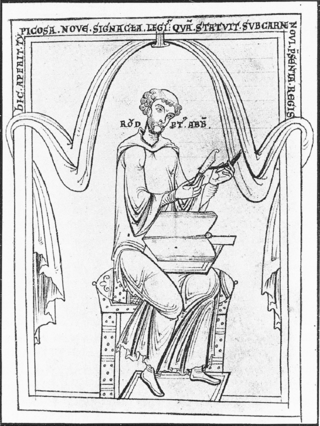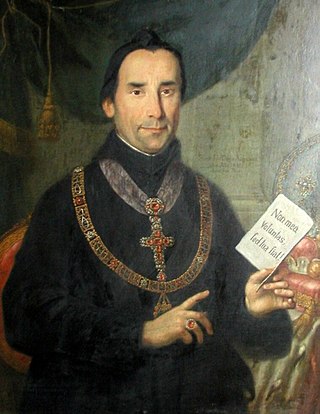
The Abbey of Saint Gall is a dissolved abbey (747–1805) in a Catholic religious complex in the city of St. Gallen in Switzerland. The Carolingian-era monastery existed from 719, founded by Saint Othmar on the spot where Saint Gall had erected his hermitage. It became an independent principality between 9th and 13th centuries, and was for many centuries one of the chief Benedictine abbeys in Europe. The library of the Abbey is one of the oldest monastic libraries in the world.

Engelberg Abbey is a Benedictine monastery in Engelberg, Canton of Obwalden, Switzerland. It was formerly in the Diocese of Constance, but is now in the Diocese of Chur. It is dedicated to Our Lady of the Angels and occupies a commanding position at the head of the Nidwalden Valley.

Einsiedeln Abbey is a Catholic monastery administered by the Benedictine Order in the village of Einsiedeln, Switzerland.

Muri Abbey was a Benedictine monastery dedicated to Saint Martin of Tours. It flourished for over eight centuries at Muri, in the Canton of Aargau, near Zürich, Switzerland. While the monastery is currently established as Muri-Gries in South Tyrol the former abbey is now a museum and heritage sites of national significance.

Conception Abbey, site of the Basilica of the Immaculate Conception, is a monastery of the Swiss-American Congregation of the Benedictine Confederation. The monastery, founded by the Swiss Engelberg Abbey in 1873 in northwest Missouri's Nodaway County, was raised to a conventual priory in 1876 and elevated to an abbey in 1881. In 2021 the community numbered fifty-eight monks who celebrate the Eucharist and Liturgy of the Hours daily and who staff and administer Conception Seminary College, The Printery House, and the Abbey Guest Center. Monks also serve as parish priests and hospital chaplains in the Roman Catholic Diocese of Kansas City-Saint Joseph and other dioceses. There is also a large postal facility attached to The Printery House, operated by lay employees, which includes package shipping and delivery facilities.

Rupert of Deutz was an influential Benedictine theologian, exegete and writer on liturgical and musical topics.

Frowin of Engleberg, in German Frowin von Engelberg was a Swiss German Benedictine abbot. Though never formally beatified, Frowin was styled "Blessed" by some chroniclers. He was the second abbot of the Monastery of Engelberg in present-day Switzerland
Roger de Bailleul was a medieval Benedictine monk, abbot of Bec, and archbishop-elect of Canterbury.

Pankraz Vorster was a Swiss abbot. He served as the last abbot of the Abbey of Saint Gall, from 1796 to 1805.
Frowin Conrad OSB was a Priest, Benedictine and first abbot of Conception Abbey.
Pater Karl Stadler, born Paul Stadler, was a Swiss Benedictine monk and artist who lived and worked in the Engelberg Abbey in the Canton of Obwalden, Switzerland. Pater Karl is best known for his works of art depicting biblical themes. His paintings, murals, and stained glass windows are on view in churches, monasteries, and public sites across Switzerland.

Gozbert was abbot of the Abbey of Saint Gall from 816 until 837 and also abbot of Rheinau Abbey until 850. The beginning of his term of office in Rheinau is unknown.
Berchtold von Falkenstein was abbot of the Benedictine Abbey of Saint Gall from 1244 until 1272.
Kaspar von Breitenlandenberg was prince abbot of the Abbey of Saint Gall from 1442 to 1463. He descended from a noble family from the Canton of Thurgau. His father was Rudolf V von Breitenlandenberg (Landenberg).

Beda Angehrn was prince-abbot of the Abbey of Saint Gall from 1767 until 1796.
Rumo von Ramstein was abbot of the Abbey of Saint Gall from 1274 until 1281.

Hildebrand de Hemptinne was a Belgium Benedictine monk of Beuron Archabbey, the second Abbot of Maredsous Abbey, and the first Abbot Primate of the Order of St. Benedict and the Benedictine Confederation.

Ignatius Conrad was a Benedictine monk, a Swiss missionary, and the first Abbot of Subiaco Abbey in Arkansas, which was named as an abbey in 1891. He served from 1892 to 1925. Fr Ignatius Conrad initially worked with the German Catholic communities in the south-western region of the United States.

Adelhelm Odermatt, OSB was the founder of Mount Angel Abbey in Oregon, and a titular abbot.

Thomas Meienhofer was the first abbot of Mount Angel Abbey in Oregon, USA,













